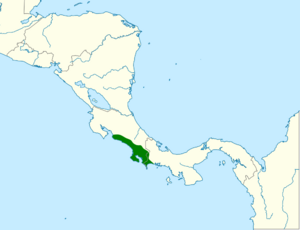Baird's trogon facts for kids
Quick facts for kids Baird's trogon |
|
|---|---|
 |
|
| Conservation status | |
| Scientific classification | |
| Genus: |
Trogon
|
| Species: |
bairdii
|
 |
|
The Baird's trogon (scientific name: Trogon bairdii) is a beautiful bird from the trogon family, which also includes the famous quetzals! You can find this bird in Costa Rica and Panama. It was named after Spencer Fullerton Baird, an important scientist from the 1800s who helped start the Smithsonian Institution.
Contents
What is Baird's Trogon?
Baird's trogon is part of a bird family called Trogonidae. This family includes many colorful birds like quetzals and other trogons. Scientists sometimes group Baird's trogon with other similar birds, but it's considered a unique species on its own.
How to Identify a Baird's Trogon?
Baird's trogon is about 25 to 28 centimeters (10 to 11 inches) long and weighs around 95 grams (3.4 ounces).
Male Baird's Trogon
Male trogons are very striking!
- Their head and most of their chest are a shiny bluish-black.
- The rest of their belly is a bright, rich red.
- They have a strong, light blue beak and a blue ring around their eyes.
- Their upper body is a metallic blue-green.
- Their wings are mostly black, with some white on the main flight feathers.
- The top of their tail feathers are greenish to violet-blue with black tips.
- The underside of their tail is white with black tips.
Female Baird's Trogon
Female trogons are a bit different:
- Instead of blue and green, their upper body is a dark slate gray.
- Their throat and chest are a lighter gray.
- Their belly has less red.
- The underside of their tail has black and white stripes.
Where Does Baird's Trogon Live?
Baird's trogon lives along the Pacific coast of Costa Rica, starting from the Tárcoles River and going south into western Panama's Chiriquí Province.
These birds mostly live deep inside humid rainforests. However, you might also spot them at the edges of these forests, in tall secondary forest (forest that has grown back after being cut down), and in shady, partly open woodlands. They can be found from sea level up to about 1,200 meters (3,900 feet) high.
What Does Baird's Trogon Do?
How Does Baird's Trogon Find Food?
Baird's trogons are clever hunters! They fly out from a perch to catch fruits and insects from leaves. They also sometimes pick up food from the ground. Very small animals are also a small part of their diet.
How Does Baird's Trogon Raise Its Young?
Baird's trogons have their babies between April and August.
- They make their nests in holes found in decaying (rotting) tree trunks.
- A female usually lays two to three eggs.
- The eggs hatch after about 16 to 17 days.
- The young birds stay in the nest for about 25 days after hatching before they are ready to fly.
What Does Baird's Trogon Sound Like?
The song of Baird's trogon is like a series of "barking" notes. It starts steady, then speeds up and drops suddenly, sometimes ending with a few widely spaced notes that are lower in pitch. When they are bothered, they also make a "sharp cackle" sound.
Is Baird's Trogon in Danger?
The IUCN (International Union for Conservation of Nature) first listed Baird's trogon as "Threatened" in 1988. However, since 2004, it has been rated as "Near Threatened." This means it's not in immediate danger, but its population could become threatened in the future.
This bird has a small natural living area, and its habitat is shrinking because of deforestation (when forests are cut down). In Costa Rica, most Baird's trogons live in protected areas, which helps keep them safe. In Panama, they are quite rare, with only a few sightings recorded in the 2000s.


